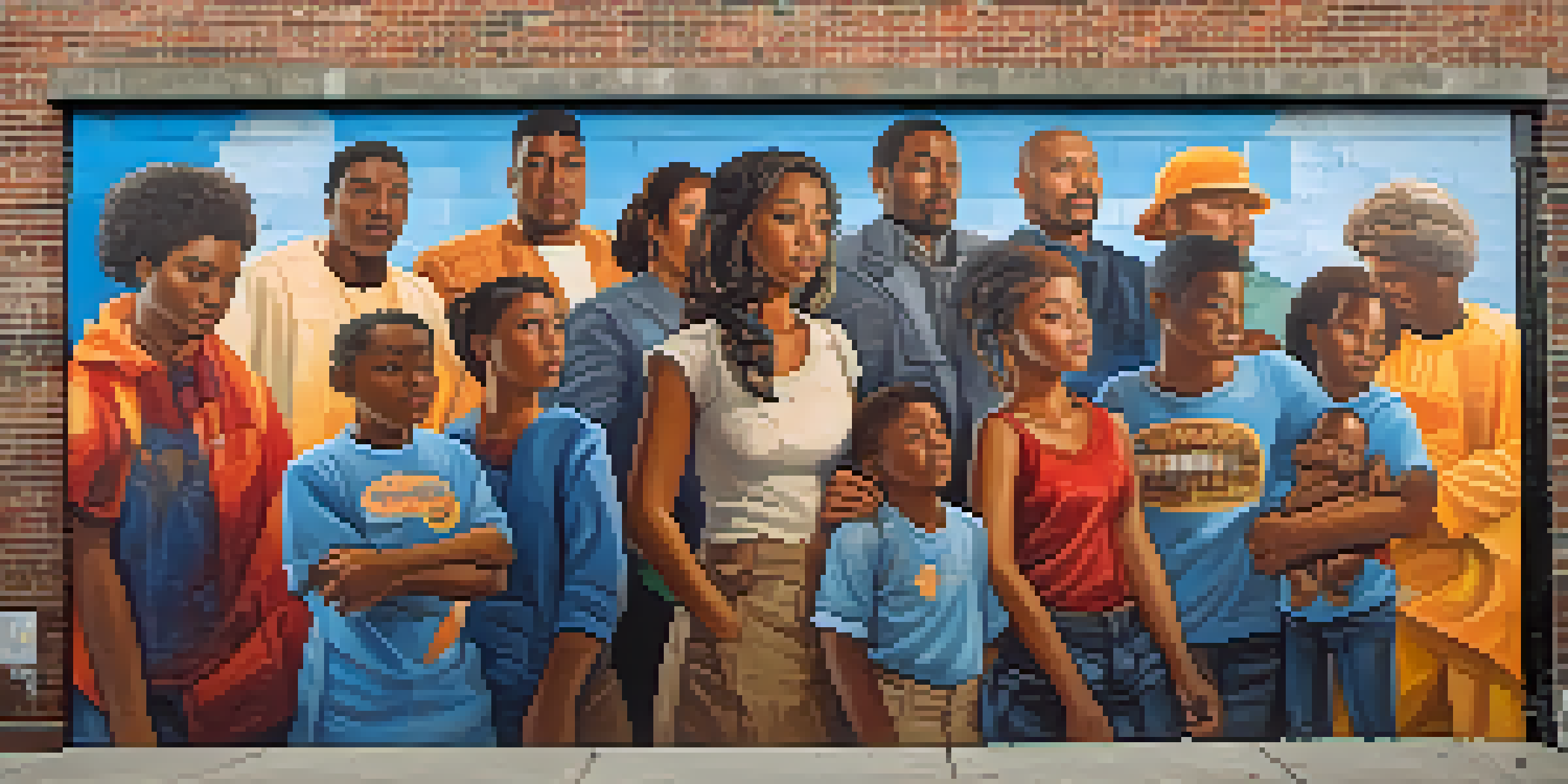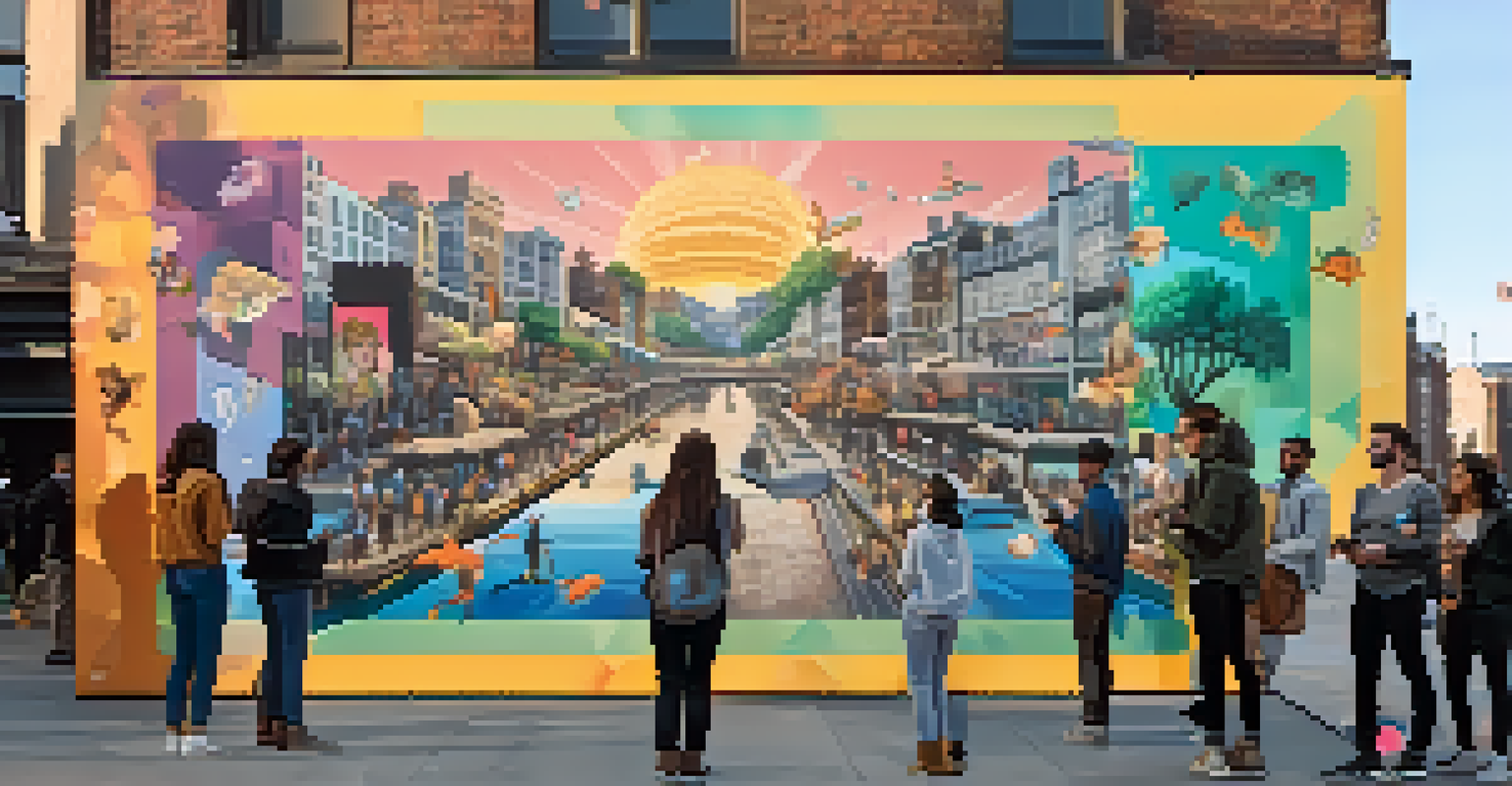The Role of Street Art in Modern Political Commentary

Street Art: The Voice of the People
Street art has emerged as a vibrant form of expression that often reflects the sentiments of the community. It provides a platform for artists to voice their opinions on pressing political issues, reaching audiences in a way that traditional media sometimes cannot. This grassroots approach invites viewers to engage with the art on a personal level, fostering a sense of shared experience and community involvement.
Art should comfort the disturbed and disturb the comfortable.
For example, murals depicting social justice themes can spark conversations about inequality and discrimination. These powerful images often resonate with individuals who feel marginalized, giving them a sense of representation and validation. In this way, street art transforms urban landscapes into canvases of dialogue, encouraging public discourse about important societal issues.
Moreover, the ephemeral nature of street art adds a layer of urgency to the messages conveyed. Artists often create their work in response to current events, making the art timely and relevant. This immediacy can amplify the impact of the message, prompting viewers to reflect on the changes they wish to see in their communities.
Historical Context of Political Street Art
The roots of political street art can be traced back to various movements throughout history. From the anti-establishment graffiti of the 1960s to the vibrant murals of the 1980s, artists have long used this medium to challenge the status quo. By analyzing past works, we can understand how street art has evolved and adapted to the shifting political landscape.

For instance, the iconic works of artists like Banksy have not only entertained but also provoked thought regarding war, capitalism, and consumerism. His pieces often blend humor with poignant social commentary, making complex issues accessible to a broader audience. This combination of artistry and activism has solidified street art's place in the realm of political discourse.
Street Art as Community Voice
Street art serves as a powerful medium for communities to express their political views and foster dialogue on pressing social issues.
Furthermore, historical events such as the Civil Rights Movement and the fall of the Berlin Wall have also inspired a surge in politically charged street art. These moments in history highlight the power of art as a tool for change, illustrating how artists can galvanize communities and inspire action through their work.
The Accessibility of Street Art
One of the most appealing aspects of street art is its accessibility. Unlike traditional forms of art displayed in galleries, street art is often found in public spaces, making it available to everyone, regardless of social status or education. This democratization of art allows for a wider range of voices to be heard, particularly those from marginalized communities.
Street art is a way to make a statement in public spaces and to create a dialogue around important issues.
Moreover, street art can transcend language barriers, as visual imagery often communicates emotions and ideas more effectively than words. A striking mural can convey a message of hope or resistance to anyone who comes across it, fostering a sense of unity among diverse groups of people. This inclusivity is vital in a world where many feel disconnected from political conversations.
In an age where social media amplifies visual content, street art can quickly gain traction online, reaching an even larger audience. Artists can share their work on platforms like Instagram, sparking discussions that extend beyond the walls of their urban canvases. This digital dimension further enhances the accessibility and impact of political street art.
Street Art as a Form of Resistance
Throughout history, street art has served as a powerful form of resistance against oppression and injustice. Artists often use their work to challenge governmental authority, highlight social issues, and rally communities toward collective action. This spirit of resistance is evident in works that confront systemic problems, such as poverty, racism, and environmental degradation.
For example, during the Black Lives Matter movement, murals dedicated to victims of police brutality emerged in cities across the globe. These artworks not only honor the lives lost but also serve as a call to action, urging society to confront systemic racism and advocate for change. This type of impactful art can mobilize communities and inspire individuals to engage in activism.
Accessibility of Street Art
The public nature of street art democratizes access to artistic expression, allowing marginalized voices to be heard and fostering unity.
Additionally, the act of creating street art itself can be seen as a form of rebellion. Many artists work outside the boundaries of traditional art institutions, choosing to express their political views through unregulated public spaces. This defiance against societal norms reinforces the idea that art can be a tool for social change.
The Role of Technology in Street Art
Technology has played a significant role in transforming how street art is created and disseminated. Artists now have access to a variety of tools, from spray paint to digital software, allowing for greater experimentation and creativity in their work. This fusion of technology and art has opened new avenues for political commentary, enabling artists to convey their messages more effectively.
Moreover, the rise of social media platforms has revolutionized how street art reaches audiences. Artists can share their creations instantly with followers around the world, garnering support and sparking conversations about the issues they address. This online presence can amplify a piece's impact, allowing for discussions that transcend geographical boundaries.
Furthermore, augmented reality (AR) technology is beginning to make its mark on street art. Some artists are incorporating AR elements into their murals, enabling viewers to interact with the artwork in innovative ways. This blending of the digital and physical realms enhances the viewer's experience, making political messages more engaging and memorable.
Challenges Faced by Street Artists
Despite its powerful potential, street art is not without its challenges. Many artists face legal repercussions for their work, especially when creating pieces on private property without permission. This risk can deter artists from expressing their opinions freely, as they weigh the consequences of their actions against their desire to make a statement.
Additionally, the commercialization of street art can dilute its original intent. As street art gains popularity, some artists find their work co-opted by corporations seeking to profit from its edgy aesthetic. This commercialization can lead to a disconnect between the artist's message and the audience's perception, ultimately undermining the political commentary that street art seeks to provide.
Challenges for Street Artists
Despite its impact, street art artists face legal risks, commercialization, and the transient nature of their work, which can hinder their message.
Moreover, the transient nature of street art poses its own set of challenges. Many pieces are painted over or removed, often within days of their completion. This impermanence can be disheartening for artists who pour their hearts into their work, knowing that their messages might not endure long enough to spark meaningful change.
The Future of Street Art in Political Discourse
As society continues to evolve, so too will the role of street art in political discourse. With rising global challenges, such as climate change and social inequality, artists will likely continue to use their platforms to address these pressing issues. The adaptability of street art allows it to respond to current events, ensuring that it remains a relevant form of commentary.
Furthermore, as technology advances, we can expect new forms of street art to emerge. Innovations in digital art and interactive experiences may provide artists with even more tools to engage audiences in meaningful ways. This evolution will likely enhance the connections between artists and their communities, fostering a deeper understanding of the issues at hand.

Ultimately, the future of street art as a vehicle for political commentary holds great potential. As artists continue to push boundaries and challenge societal norms, their work will inspire future generations to reflect on the world around them and take action toward positive change.